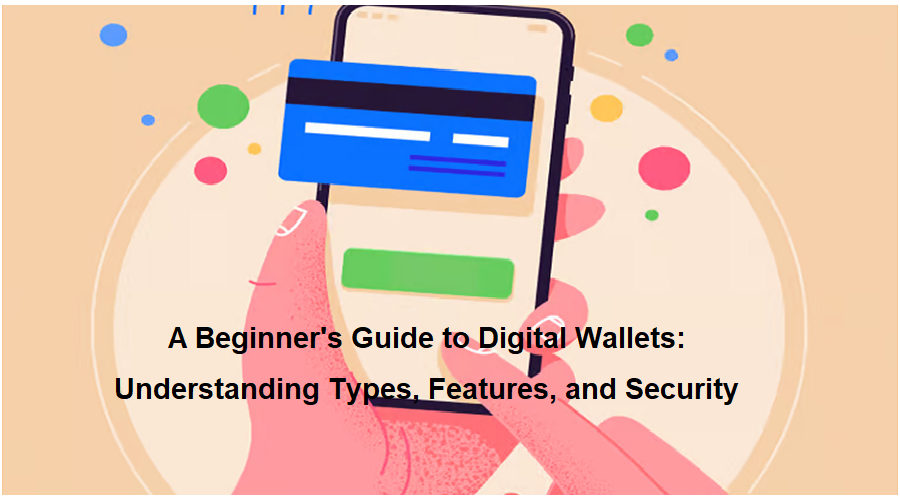A Beginner’s Guide to Digital Wallets: Understanding Types, Features, and Security

Digital wallets have become increasingly popular over the past few years, as more and more people look for convenient and secure ways to make payments online and in-store.
In fact, according to a recent report by Grand View Research, the global digital wallet market is expected to reach $51.53 billion by 2030, growing at a compound annual growth rate of 27.4%. This is a clear indication of the increasing adoption of digital wallets around the world.
Simply put, a digital wallet is a software-based system that securely stores users’ payment information, including credit and debit card details, bank account information, and even cryptocurrency.
Digital wallets come in various types, each with its unique features and security measures. In this beginner’s guide to digital wallets, we’ll explore the different types of digital wallets, their features, and security measures.
We’ll also discuss tips on how to choose a digital wallet that suits your needs and preferences. So let’s dive in and understand each aspect one by one.
Types of Digital Wallets
——————————-
Now that we know what digital wallets are, it’s important to note that there are different types of digital wallets prevalent in payment markets. In this section, we’ll explore the different types of digital wallets and how they work.
Mobile Wallets
Mobile wallets are the most commonly used digital wallets, and for good reason. Some of the benefits of mobile wallets are that they are easy to use and convenient, as they allow you to make payments using your smartphone or smartwatch.
Some popular examples of mobile wallets include Apple Pay, Google Pay, and Samsung Pay. These wallets work by securely storing your payment information on your device and using near-field communication (NFC) technology to communicate with payment terminals.
Mobile wallets are also known for their loyalty and reward programs, making them an attractive option for frequent shoppers.
Web-based Wallets
Web-based wallets, also known as online wallets, are another type of digital wallet. Unlike mobile wallets, they are accessed through a web browser on a desktop or mobile device.
Some popular examples of web-based wallets include PayPal and Skrill. Web-based wallets work by securely storing your payment information on the wallet provider’s server. They are ideal for online shopping and transferring funds to other users.
Hardware Wallets
Hardware wallets, also known as cold wallets, are the most secure type of digital wallet. These physical devices, such as the Ledger Nano S and Trezor, are designed to store your payment information offline, away from potential cyber threats.
Hardware wallets work by generating a private key that is stored on the device and is used to sign transactions. They are ideal for storing large amounts of cryptocurrency or for those who prioritize security above all else.
Features of Digital Wallets
The above-discussed types of digital wallets are most commonly used in digital payments. However, mobile wallets are something among these types of wallets, that you can see in almost everyone’s smartphones.
However, it’s the features of digital wallets that make them so widespread and popular. Some of the most essential features of digital wallets are.
Contactless Payments
Contactless payments are one of the most convenient mobile payment solutions in digital wallets. They allow you to make payments by simply tapping your device on a payment terminal, without the need for physical contact or a PIN.
This feature is available on most mobile wallets, such as Apple Pay and Google Pay.
Loyalty and Rewards Programs
Many digital wallets offer loyalty and rewards programs that allow you to earn points or cashback for every purchase you make.
These programs are designed to encourage you to use the wallet for all your payments and can be a great way to save money on everyday expenses.
Split Payments
Some digital wallets, such as Venmo and Zelle, offer split payment features that allow you to split the cost of a purchase with friends or family members. This is especially useful for group purchases, such as meals or travel expenses.
Budgeting Tools
Digital wallets can also help you keep track of your spending and manage your budget. Many wallets offer tools and features that allow you to set spending limits, categorize your purchases, and create savings goals.
Fraud Protection
Digital wallets are designed with security in mind, and many offer advanced fraud protection features such as two-factor authentication and biometric authentication. This helps to keep your payment information secure and protects you against unauthorized transactions.
Examples of digital wallets that offer security features include:
MyEtherWallet: A web-based wallet that offers two-factor authentication and hardware wallet integration to ensure maximum security.
Apple Pay: A mobile wallet that uses biometric authentication (such as Touch ID or Face ID) to authorize transactions, ensuring that only the authorized user can make purchases.
Integration with Multiple Currencies
Digital wallets that support multiple currencies allow users to store, manage, and exchange different types of digital currency.
Examples of digital wallets that offer integration with multiple currencies include:
Exodus: A desktop and mobile wallet that supports over 100 cryptocurrencies, including Bitcoin, Ethereum, and Litecoin.
Abra: A mobile wallet that supports over 100 cryptocurrencies and fiat currencies, allowing users to easily exchange between them.
Secure Storage
One of the primary functions of a digital wallet is to securely store digital currency.
This feature ensures that the digital currency is safe and protected from unauthorized access or theft.
Examples of digital wallets that offer secure storage include:
Ledger Nano S: A hardware wallet that stores cryptocurrencies offline, providing maximum security against cyber attacks.
Coinbase: A digital wallet that offers vault storage for cryptocurrencies, which requires multiple approvals and time-delayed withdrawals for added security.
Security Measures in Digital Wallets
——————————-
Digital wallets have become increasingly popular due to their exceptional features, convenience, and ease of use they provide However, with the rise of digital payments, security concerns have also emerged.
In this section, we’ll explore the security measures in digital wallets and how they protect your payment information.
Encryption
Encryption is a critical security measure used in digital wallets. It involves encoding your payment information using complex algorithms, making it difficult for cybercriminals to decipher.
Most digital wallets use advanced encryption technologies such as SSL and TLS to ensure that your payment information remains secure.
Two-Factor Authentication
Two-factor authentication (2FA) is another security measure used in digital wallets. This involves adding an additional layer of security by requiring a second form of authentication, such as a fingerprint or a one-time code sent to your phone.
2FA helps to prevent unauthorized access to your wallet and keeps your payment information safe.
Biometric Authentication
Many digital wallets now support biometric authentication, such as facial recognition and fingerprint scanning. Biometric authentication provides an added layer of security and ensures that only you can access your payment information.
Fraud Monitoring
Digital wallets often have sophisticated fraud monitoring systems in place that can detect unusual activity and alert you to potential security breaches. These systems help to prevent fraud and protect your payment information from unauthorized use.
Secure Storage
Digital wallets store your payment information, such as your credit card details and bank account information. Therefore, they must use secure storage methods to protect this sensitive data.
Most digital wallets use secure servers and employ strict access controls to ensure that your payment information is kept safe.
User Education
Users should be educated about best practices for using digital wallets, such as not sharing passwords, checking transaction histories regularly, and reporting any suspicious activity to the provider.
How to Choose a Right Digital Wallet
——————————-
With so many digital wallets available, choosing the right one for your needs can be overwhelming. However, by considering a few key factors, you can narrow down your options and select the digital wallet that’s right for you.
In this section, we’ll explore how to choose the right digital wallet.
Compatibility
Before choosing a digital wallet, it’s essential to check whether it’s compatible with your device and operating system. Some digital wallets are only available on specific platforms, so it’s important to choose one that works with your device.
Security
Security should be a top consideration when choosing a digital wallet. Look for wallets that offer advanced security measures such as encryption, two-factor authentication, and biometric authentication. Additionally, consider the wallet’s reputation and history of security breaches.
User Experience
The user experience is another critical factor to consider when choosing a digital wallet. Look for wallets that are easy to use, have a simple interface, and offer a seamless payment experience. Consider reading user reviews and ratings to get an idea of the wallet’s user experience.
Features
Different digital wallets offer various features, so consider what features are important to you. Do you need a wallet that supports contactless payments, loyalty programs, or budgeting tools? Choose a wallet that offers the features that are important to you.
Fees
Finally, consider the fees associated with the digital wallet. Some wallets may charge fees for transactions or account maintenance, while others may be free. Make sure to read the fine print and understand the fees associated with the wallet before choosing one.
Conclusion
Digital wallets offer a convenient and secure way to make digital payments. By understanding the types of digital wallets available, their features, and security measures, you can choose a wallet that meets your needs and provides peace of mind when making digital payments.
Whether you’re looking for a wallet that supports contactless payments or budgeting tools, there’s a digital wallet out there for you. Just remember to consider compatibility, security, user experience, features, and fees when choosing a wallet.
With the right digital wallet, you can enjoy the convenience of digital payments while keeping your payment information safe and secure.




